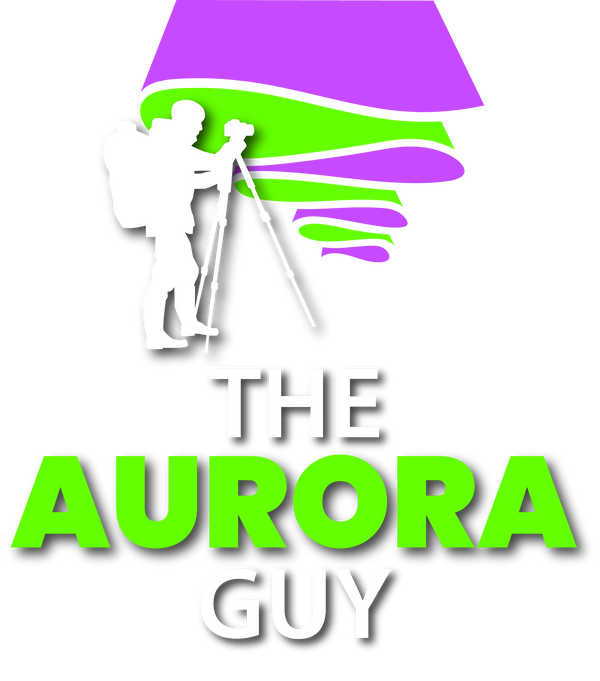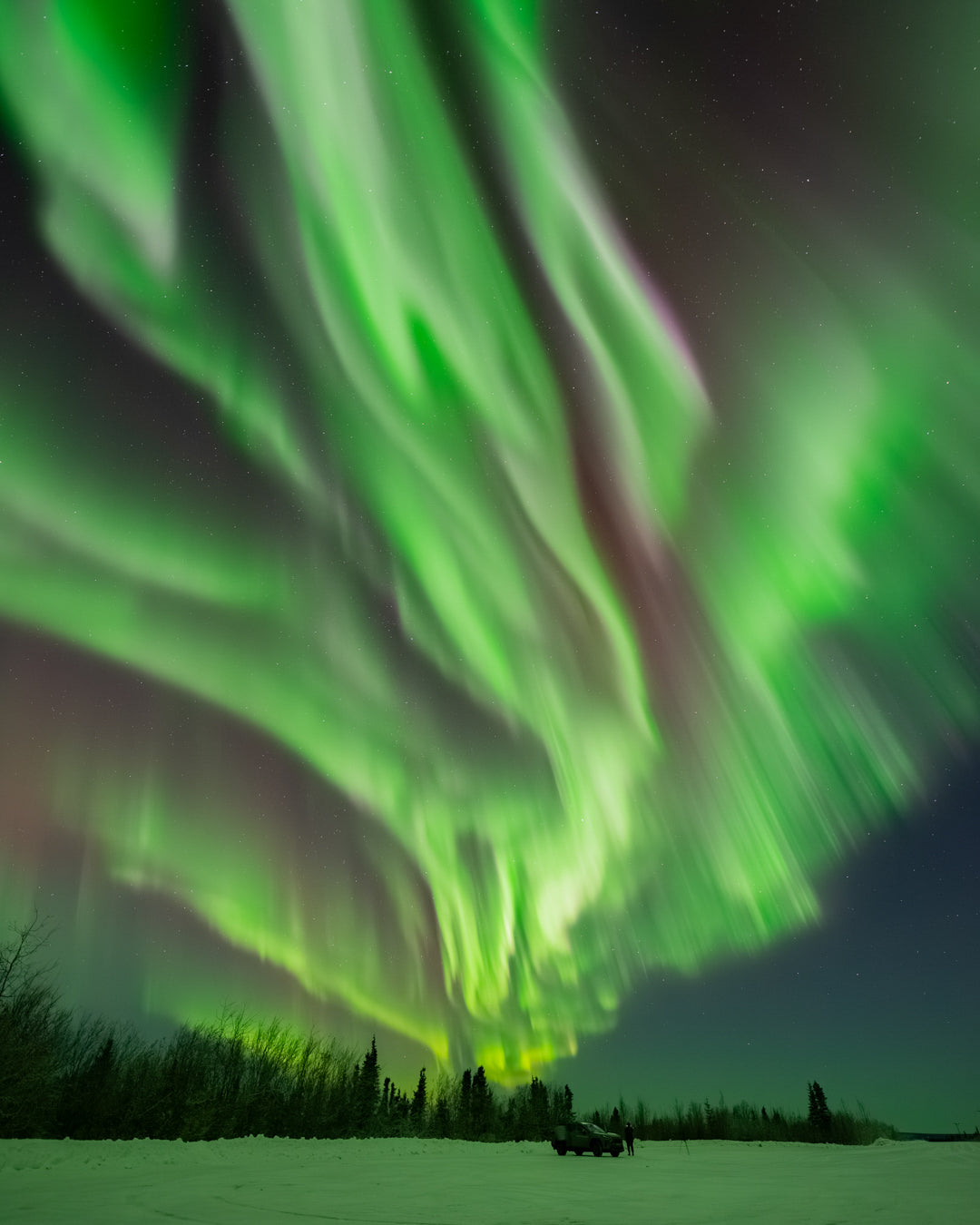
Heading to Alaska to see the aurora? Hire a guide to maximize your chances!
A dedicated tour is the best way to see the aurora on your trip to Alaska, but not all guides are worth hiring! Since moving to Fairbanks, I have met personally with many tour operators and have given a few my official approval!
Recommended tours:
-
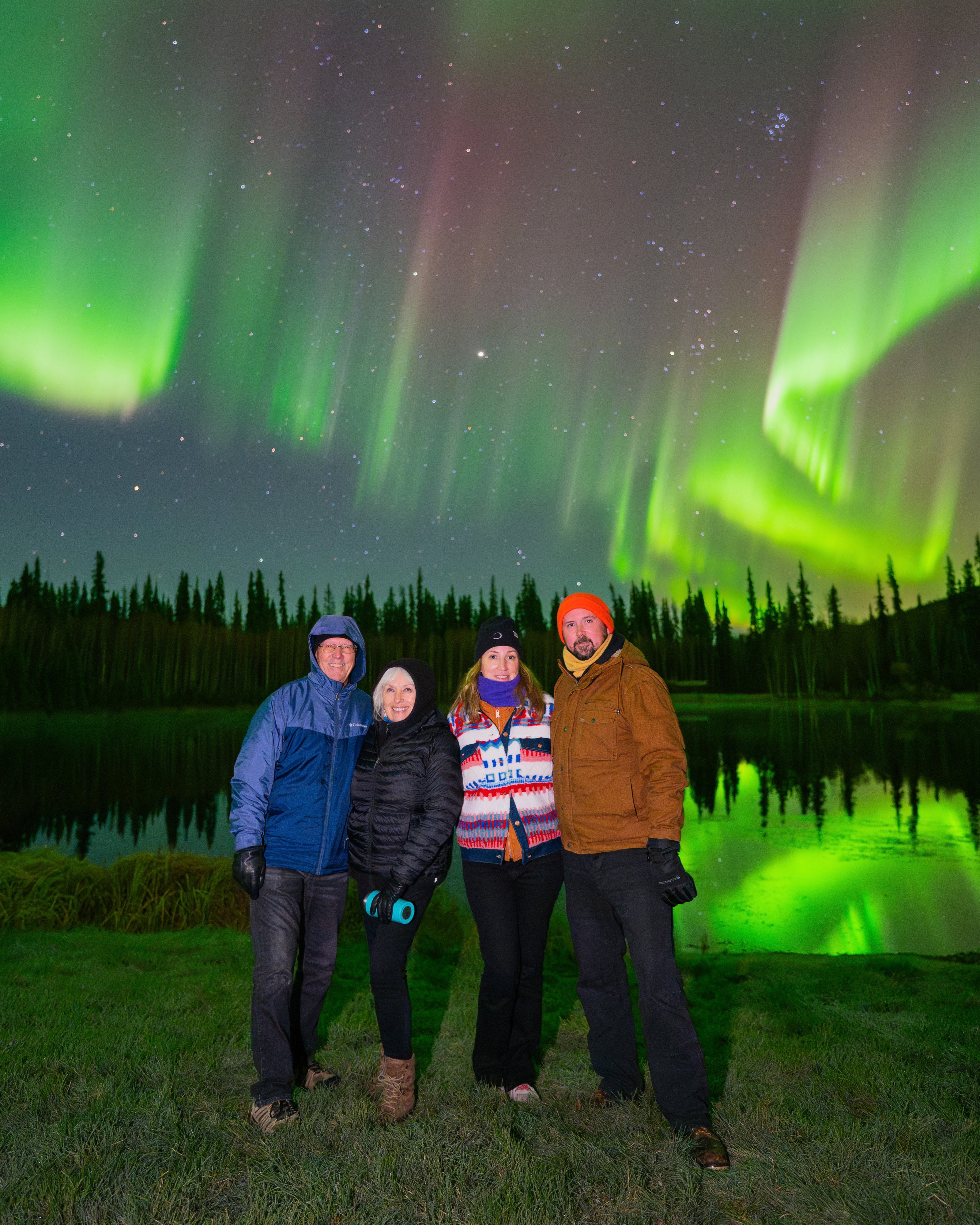
Maia's Aurora Tours
Book now!Quick Details:
- Professional aurora chaser
- $350 (solo traveler)
- Private tours: $1500 (group of five; $250 savings, each additional person is $100 up to a max. six people)
- Photos included
- For all ages!
- 6-9 hours
- Fairbanks-area lodging pick up/drop off
- 98% success since starting tours in 2024!
What makes this tour unique? If you have small children or babies or want a more intimate experience under the northern lights, this tour is for you. Maia is my roommate in Alaska, and I've known her for a long time. I partnered with Maia in 2024 to run aurora tours in the Fairbanks area. Maia knows her stuff and is a full-time aurora tour guide. Check out nighly tour highlights on Maia's instagram feed!
-

Levi's Aurora Tours
Check availabilityQuick Details:
- Professional aurora chaser
- $350 (solo traveler)
- Private tours: $1500 (group of five; $250 savings, each additional person is $100 up to a max. six people)
- Photos included
- For all ages!
- 6-9 hours
- Fairbanks-area lodging pick up/drop off
- New tour guide collaborating with The Aurora Guy LLC!
What makes this tour unique? If you have small children or babies or want a more intimate experience under the northern lights, this tour is for you. Levi started guiding for me in November 2025, but I have known him for years. He is a professional photographer and pilot and has seen the aurora with me around the world.
-
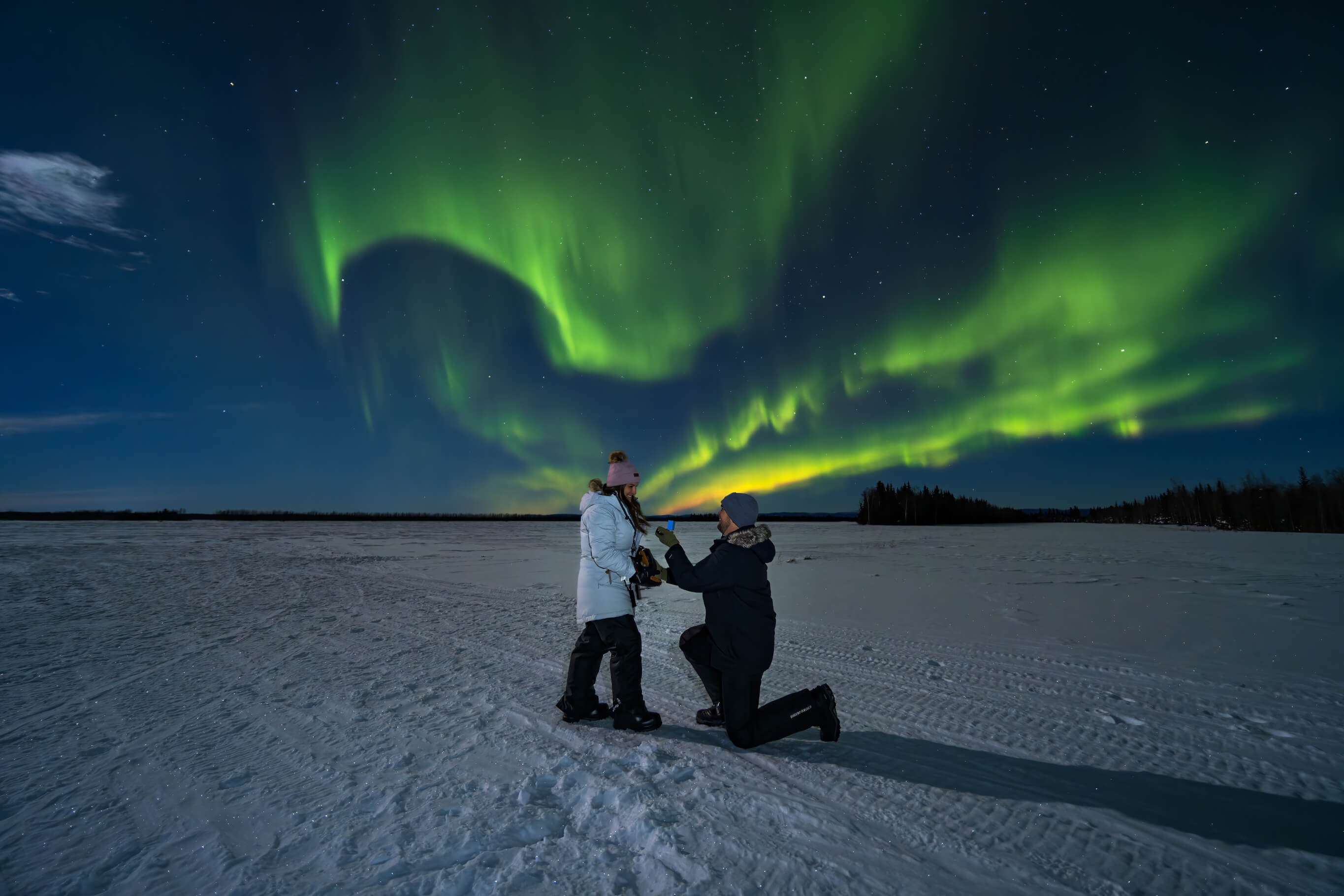
Face the Outdoors
Book now!Quick Details:
- Guided by Mike Schultz, a native Alaskan!
- Travel to the aurora viewing lodge!
- $275 (solo traveler)
- $265 per person (groups 2+)
- Ages 8+
- Private tours (up to 8 people)
- (ALL ages on private tours)
- Pickup/dropoff from Fairbanks-area hotels
What makes this tour unique? Mike was born and raised in Alaska and has immense local knowledge and insights - more than ANY aurora guide I know. The aurora viewing lodge in Delta Junction is a great place to warm up and wait for the lights to appear. The property is wide and open, allowing for unparalleled views of the sky. The warming lodge makes this tour perfect for everyone including older or low-mobility guests. Families with younger kids or babies should book a private tour.
-
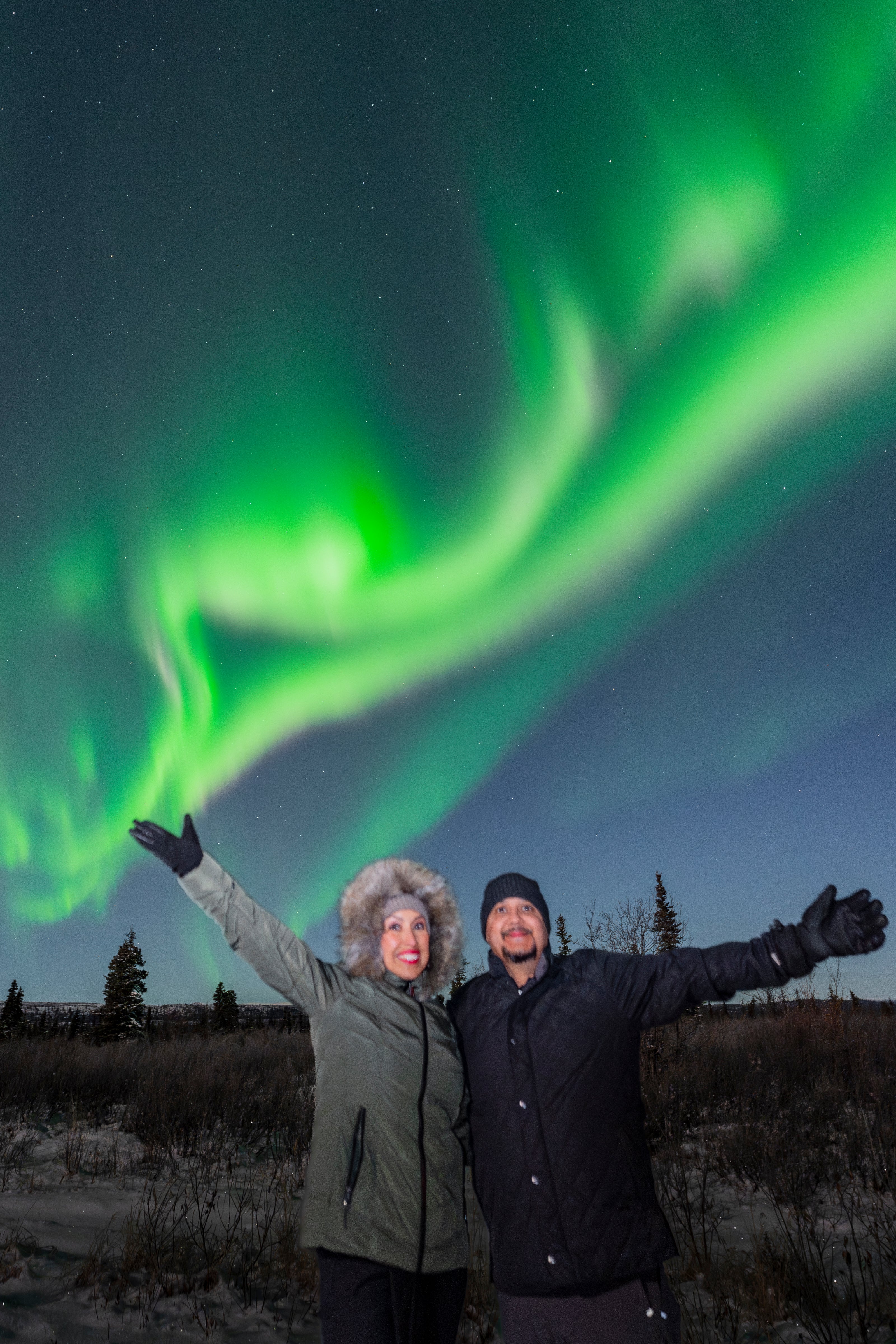
Greatland Adventures
Book now!Quick details:
- Highest-rated aurora tours in Alaska
- Tours available in ANCHORAGE as well!
- $325 per person
- $1995: flat rate for groups up to 8 people
- $100 per each additional person up to 12 People
- Pickup/dropoff from area hotels
What makes this tour unique? Greatland Adventures is an award-winning tour company in Alaska that is driven by creating the best customer experience possible. Tours are available in Anchorage and Fairbanks. Fairbanks tours stop by Greatland's property north of Fairbanks with warming huts and great viewing areas under dark skies.
-
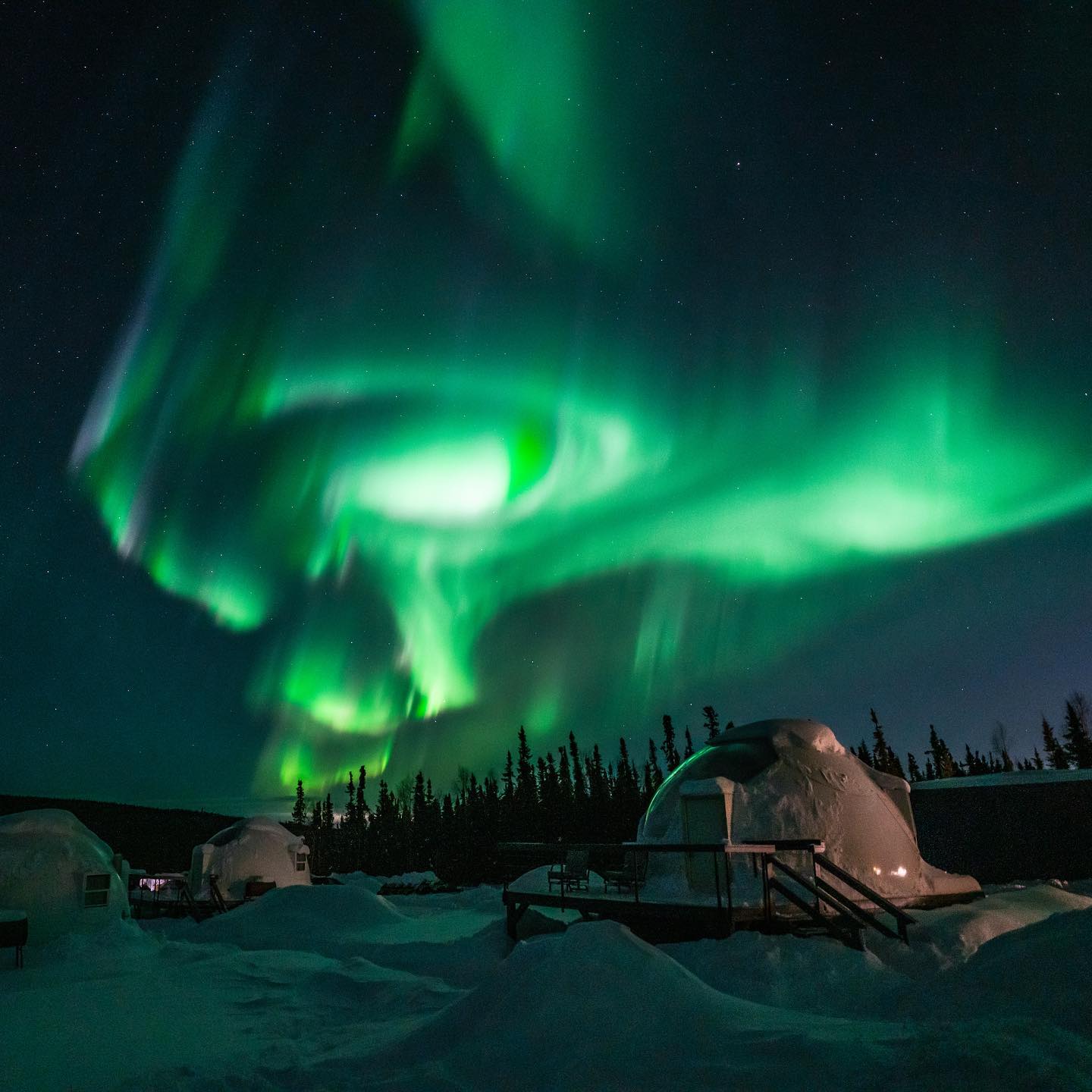
Gondwana Ecotours
Book now!Quick details:
- Multi-day tours in the Alaskan interior
- Three, full-time expert guides per trip
- 99% success rate over the past three seasons
- Length: 8 days
- Departs: Sep-Apr
- Capacity: 14-18 people
What makes this tour unique? This is the PERFECT option for the traveler that wants a complete experience from start to finish. Gondwana Ecotours is a full-serivice tour company committed to unique, authentic experiences. Not only will you have expert aurora guides on your trip who will wake you up when the aruora appears, but tons of fun experiences like going to Chena Hot Springs, dogsledding, museum tours, traditional Alaska native meals, and more!
-
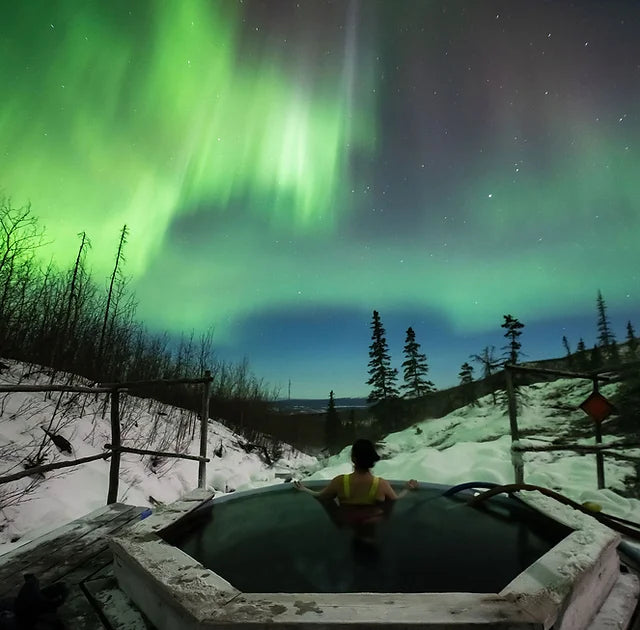
Arctic Dog Adventure Co.
Book now!Two types of multi-day aurora tours are available:
"Hut to hut"
- 5- and 7-day excursions
- Journey starts from Fairbanks
- Journey to mushing huts in the White Mountains
- No previous mushing experience required
Tolavana Hot Springs
- 4-day excursion starting and ending in Fairbanks
- Destination: Tolavana Hot Springs
- Moderate difficulty
What makes this tour unique? Experiencing the aurora while on a tour with Arctic Dog Adventure Co. is truly unique and incredible. These multi-day excursions are for the adventurer looking for unique photos no one else can replicate. Make your trip to Alaska unforgettable!
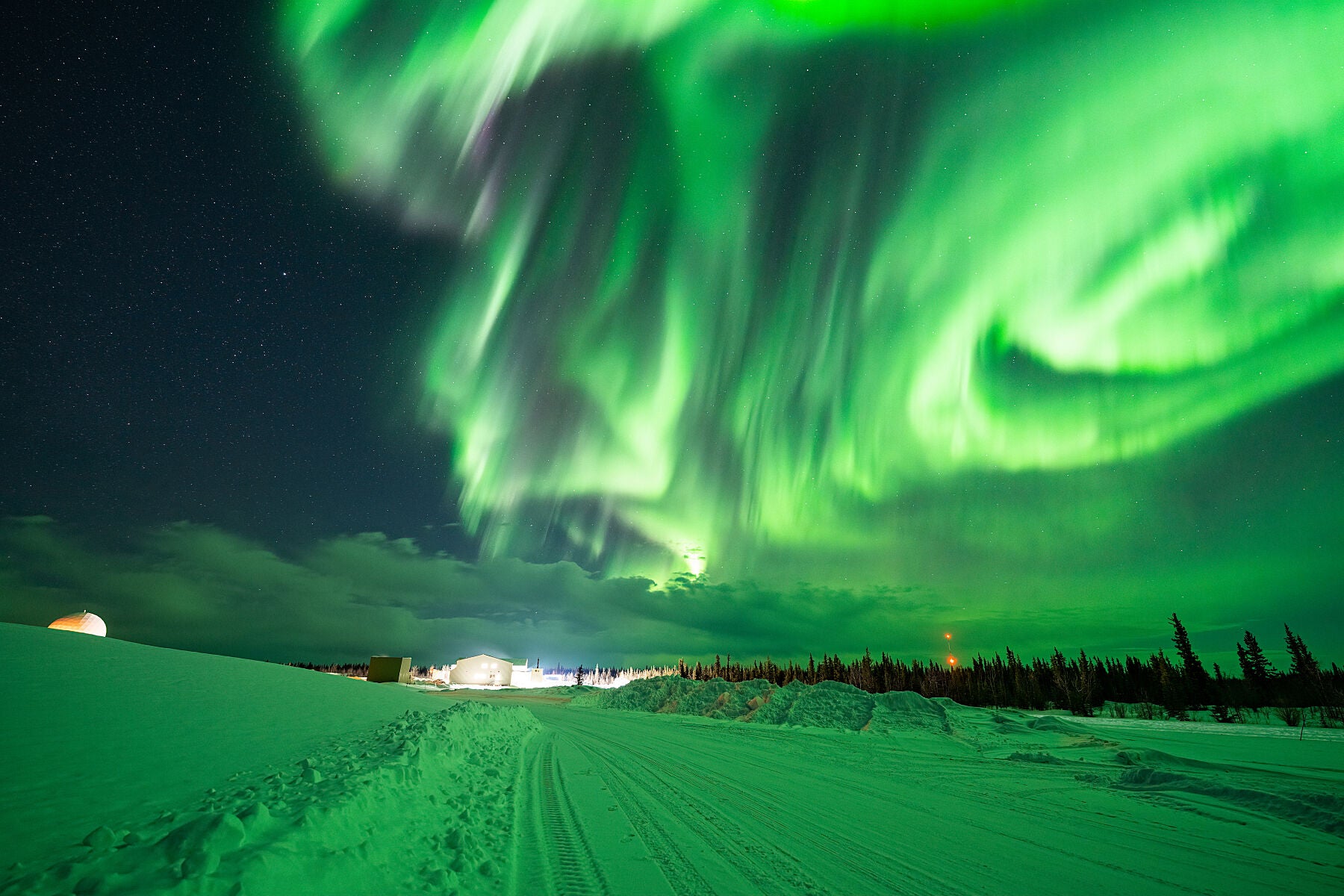
First time visiting Fairbanks?
Don't worry! I have all the info on where to stay, what to pack, and what to do during the day!

First time visiting Anchorage?
Anchorage is a great base for a variety Alaskan adventures. Find out the best things to do in Anchorage and where to go to see the aurora in my visitor's guide:
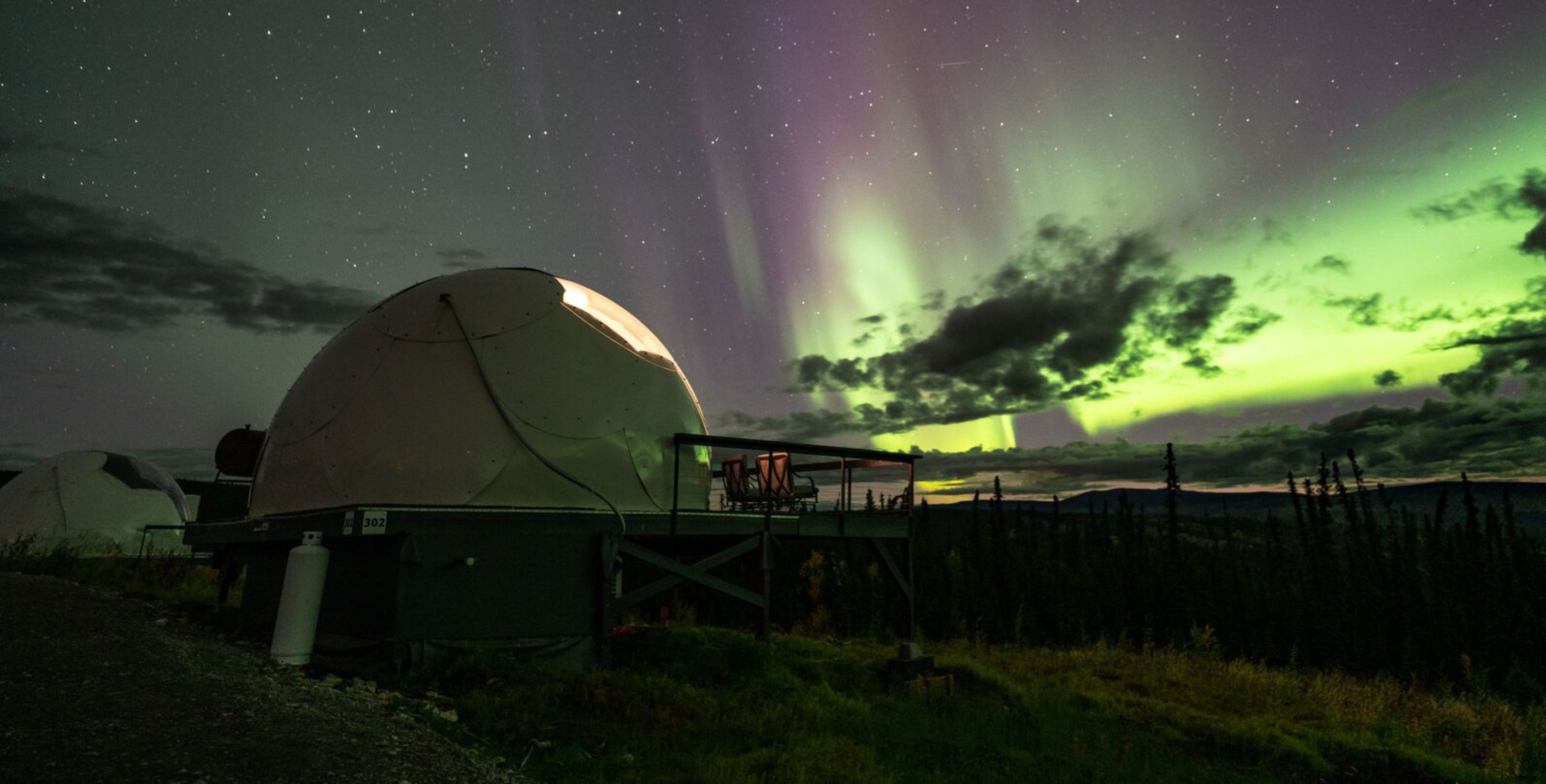
What's the best place to stay in Fairbanks?
Picking the right lodging is important so you can watch the aurora as much as you want! Picking the wrong lodge could ruin your chances of seeing the northern lights.
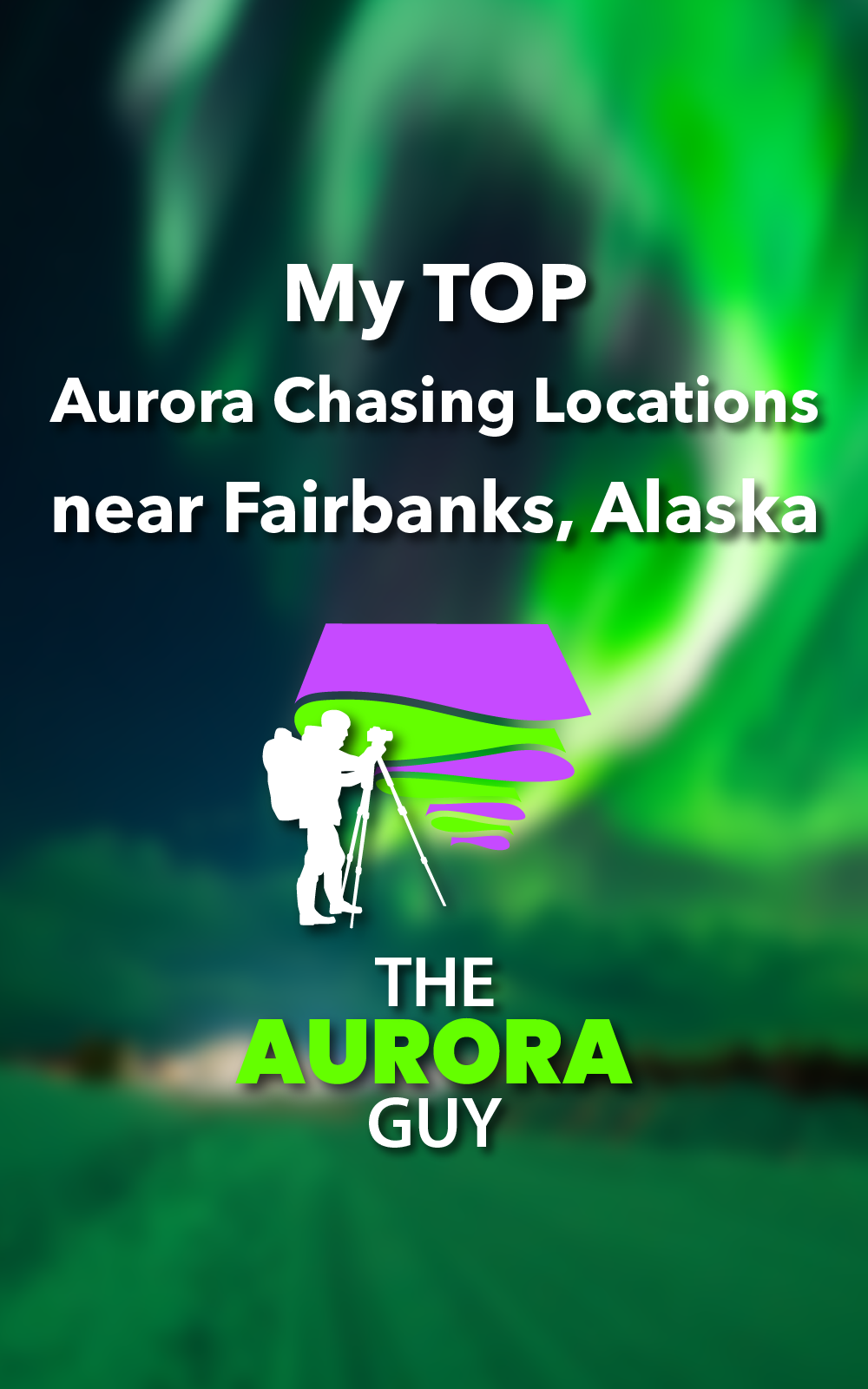
Trying to chase the aurora on your own in Fairbanks, Alaska? Well, it's possible, but you really need to know where to go! This e-book is full of insider aurora chasing knowledge, revealing my top aurora chasing locations for all types of viewing - whether you're looking for a huge open area for large groups or specific compositions for a photoshoot, this e-book will break it down for you. Also included inside this e-book is a custom google map you can plug directly in your phone!
E-Book: My Top Aurora Chasing Locations near Fairbanks, Alaska
Share
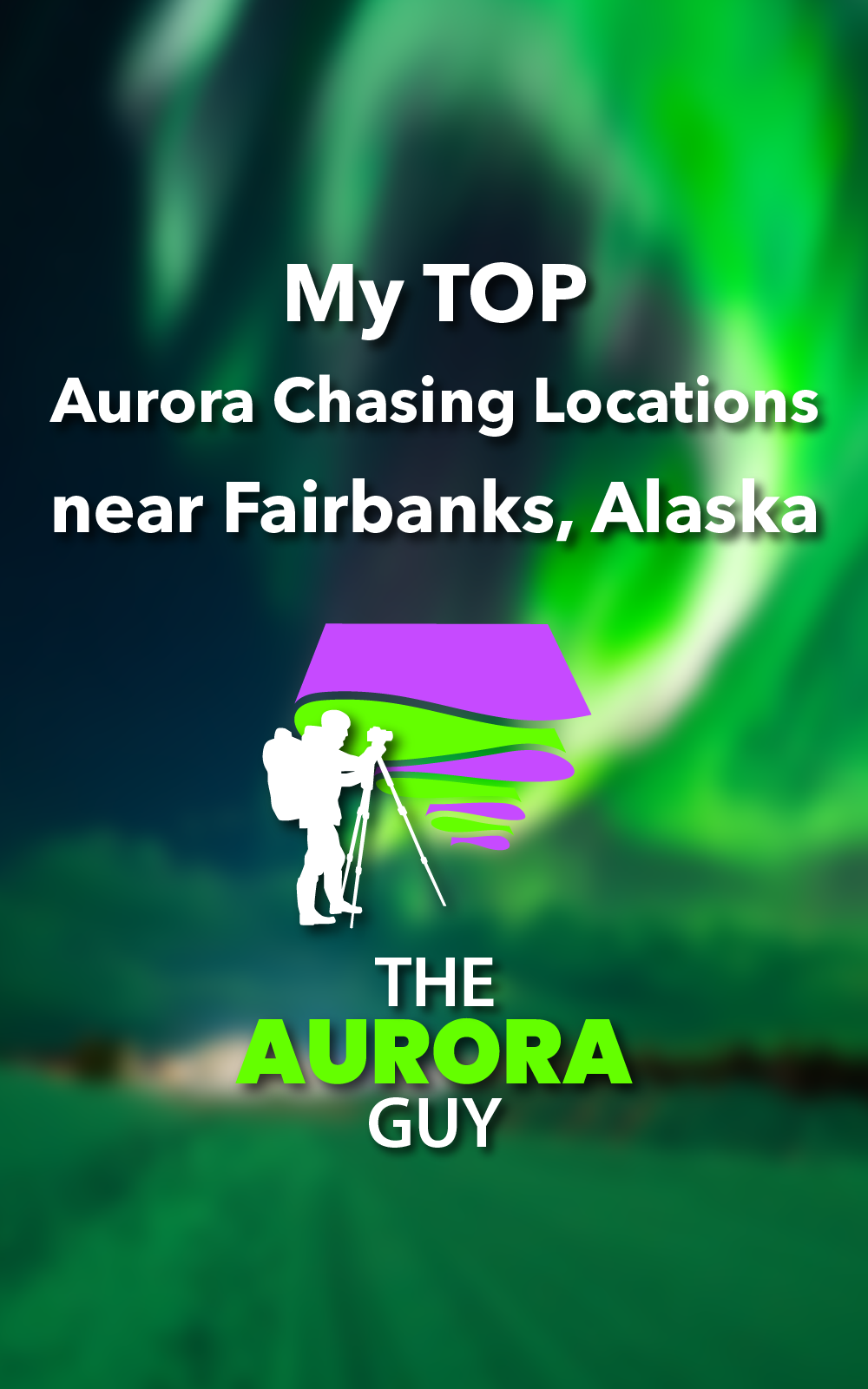
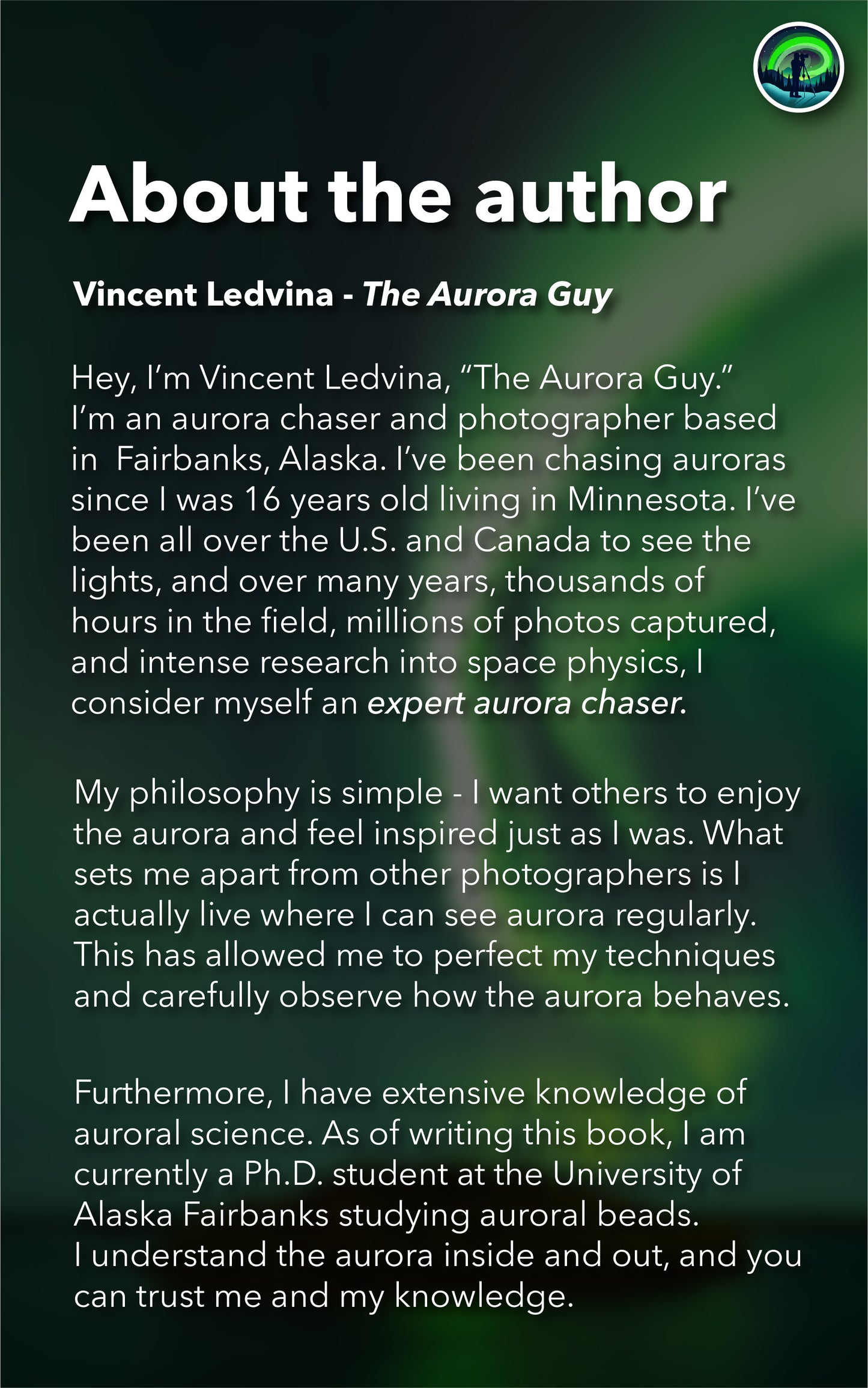
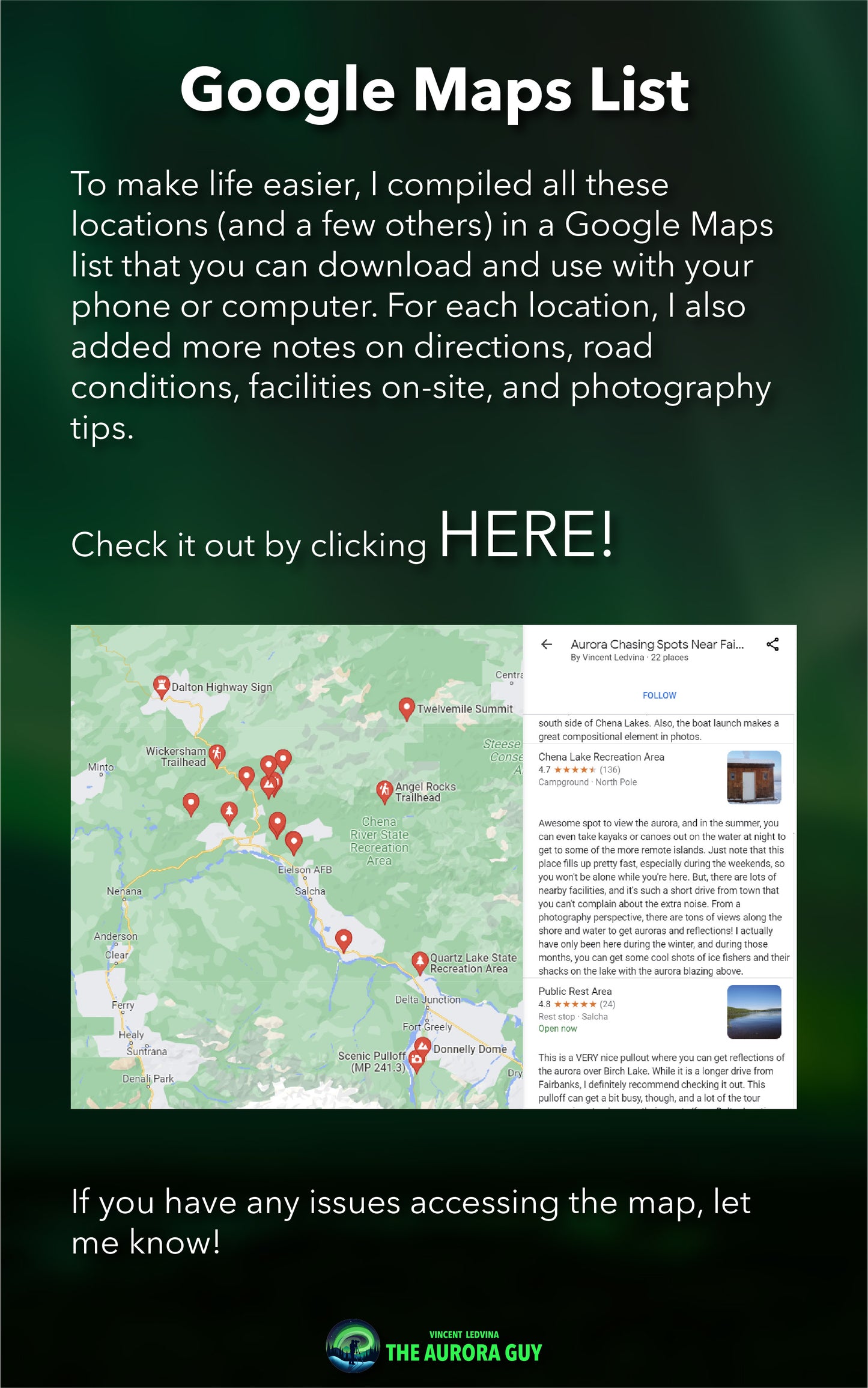
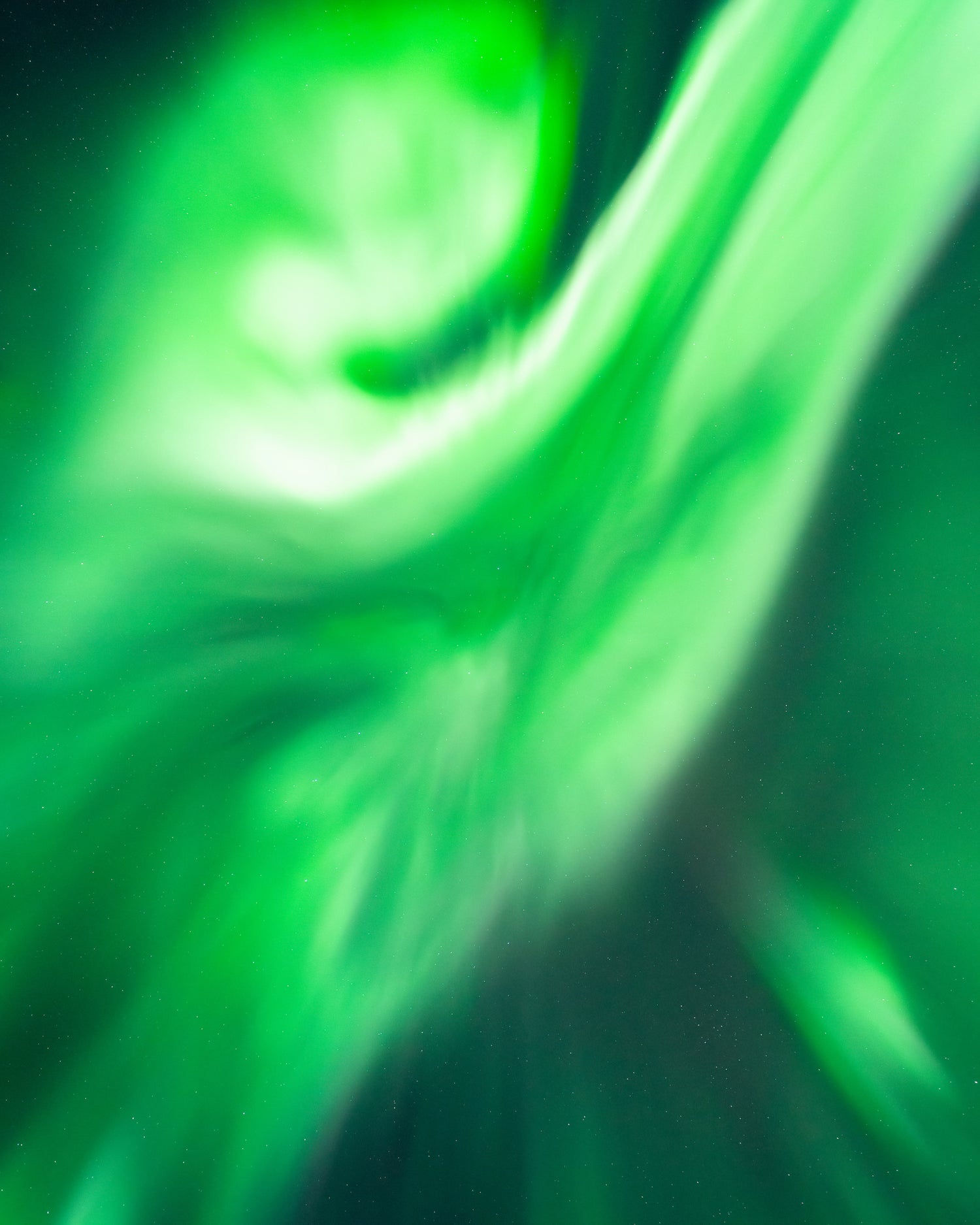
How to see the aurora in Alaska
The aurora borealis is one of nature’s most breathtaking sights, and with the right tools and knowledge, you can learn how to chase and enjoy it on your own. Fairbanks is one of the best places in the world to see the aurora, as it sits directly under the auroral oval. This means the lights are out every night during the aurora season, which lasts from late August to mid-April in Fairbanks. In Anchorage, aurora season starts a bit earlier in early August and lasts until mid-May, though the lights are often visible lower on the horizon rather than directly overhead.
Summer months are too bright to see the aurora, as the sun doesn’t set long enough for the skies to darken. Clear skies are key to spotting the aurora, and February through April is typically the clearest time of year across most of Alaska. These months are also the most popular for aurora chasing because of the "equinox effect," which enhances auroral activity during the months surrounding the equinoxes in March and September.
The aurora typically peaks between 12-2 am, when auroral substorms are most likely to occur. These substorms create the brightest and most colorful displays but usually only last about 30 minutes. Tools like the GOES magnetometer can help predict when substorms are about to happen, but experienced aurora guides are often your best resource for knowing when these bursts of activity will light up the sky.
To help you get started, download my Beginner’s Guide to Aurora Chasing e-book for free when you subscribe to my email list. This guide explains everything you need to know about aurora hunting, from reading space weather data to picking the best locations. My e-book Top Aurora Chasing Locations in Fairbanks also highlights the best viewing spots in the area and is an affordable alternative to joining a guided tour.
There are some myths about aurora chasing that I want to clear up:
- Kp Index Doesn’t Matter: You can see the aurora in Fairbanks even at a Kp 0! Some of the best displays happen during low Kp levels.
- The Moon Phase Doesn’t Matter: The aurora is bright enough to shine through any moon phase. If you’re taking photos with a smartphone, a full moon will help illuminate the landscape. Professional photographers might prefer darker skies during a new or third-quarter moon for better contrast, but a bright moon can beautifully reflect the aurora’s green glow on the ground.
For the best chance of success, hiring an aurora guide can make your experience even more rewarding. Guides know the top spots, can read the data, and help you see the aurora even on tricky nights.
Daytime tours and activities in Alaska:
-
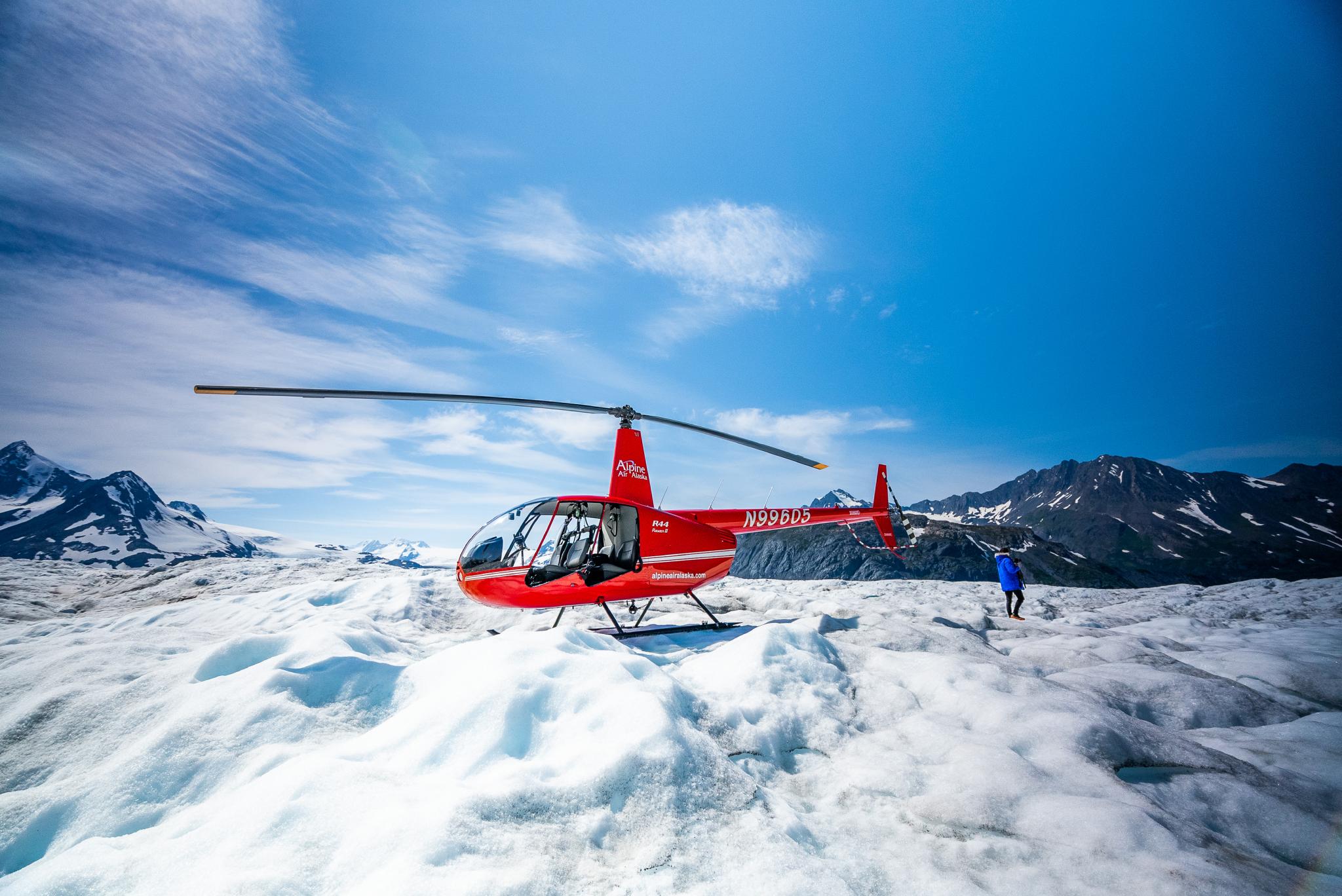
Glaciers and Ice Caves Helicopter Tours
Book now!Experience Alaska's glaciers up close via helicopter. Drive a dog sled to an ice cave, go fat tire biking over thousand-year-old ice, or drink some of the purest water on the planet.
-
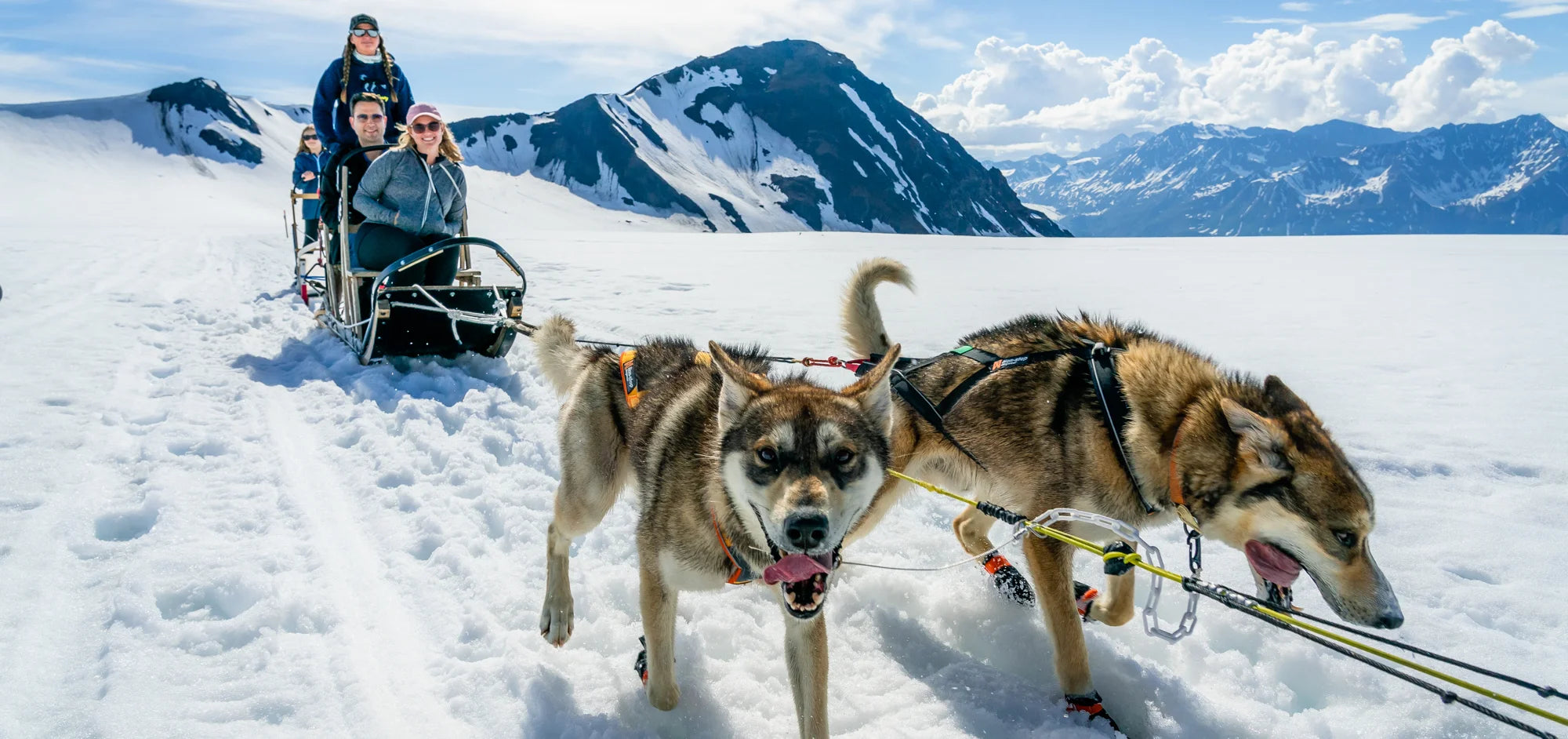
Dogsledding Tours
Book now!Dog sledding is at the heart of Alaska with the Iditarod and Yukon Quest races every year. Experience the thrill of mushing - tours run all year long!
-
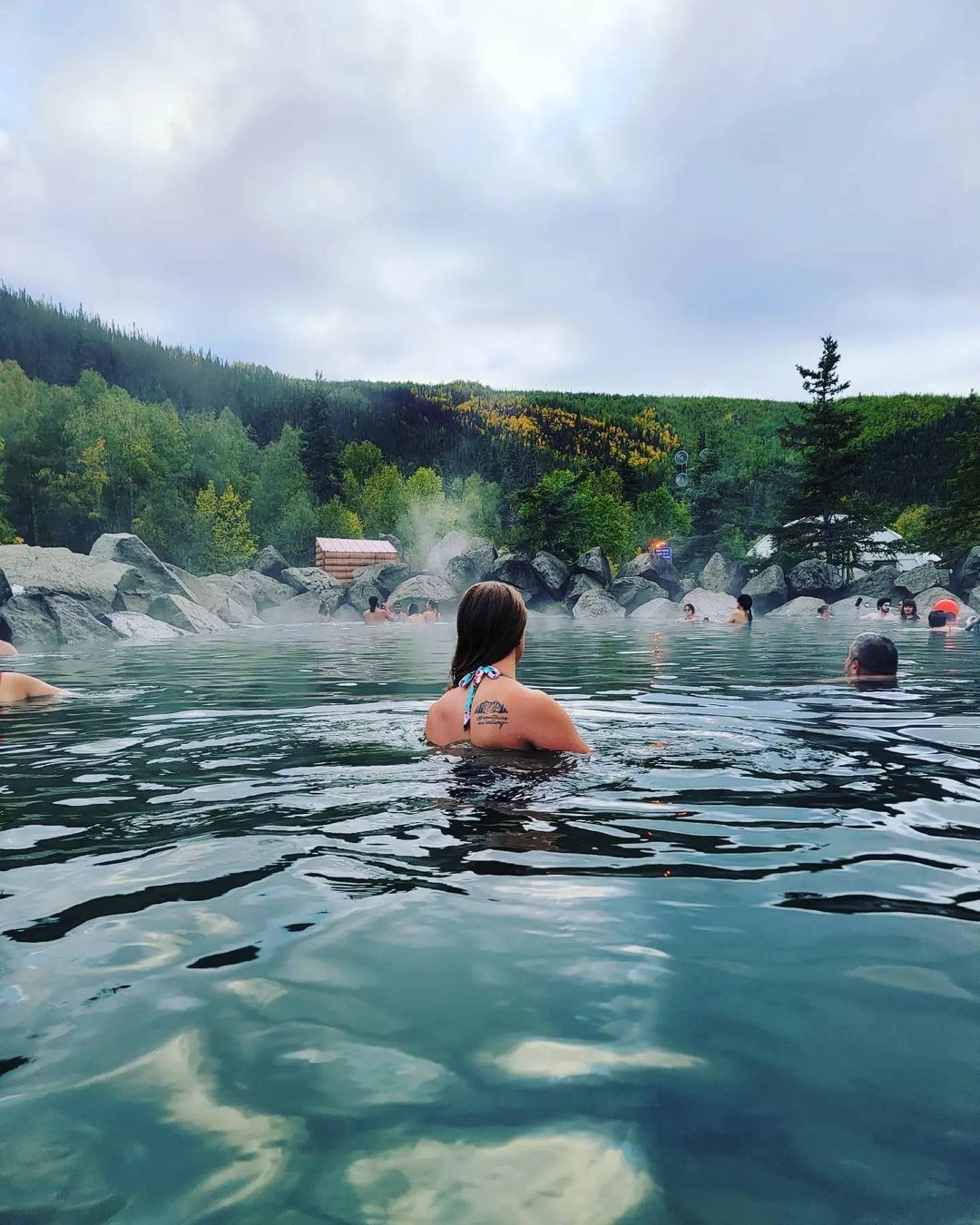
Chena Hot Springs
Book a tour!One of the most famous hot springs in the world, Chena Hot Springs is a must-visit on any trip to the Fairbanks area.
-
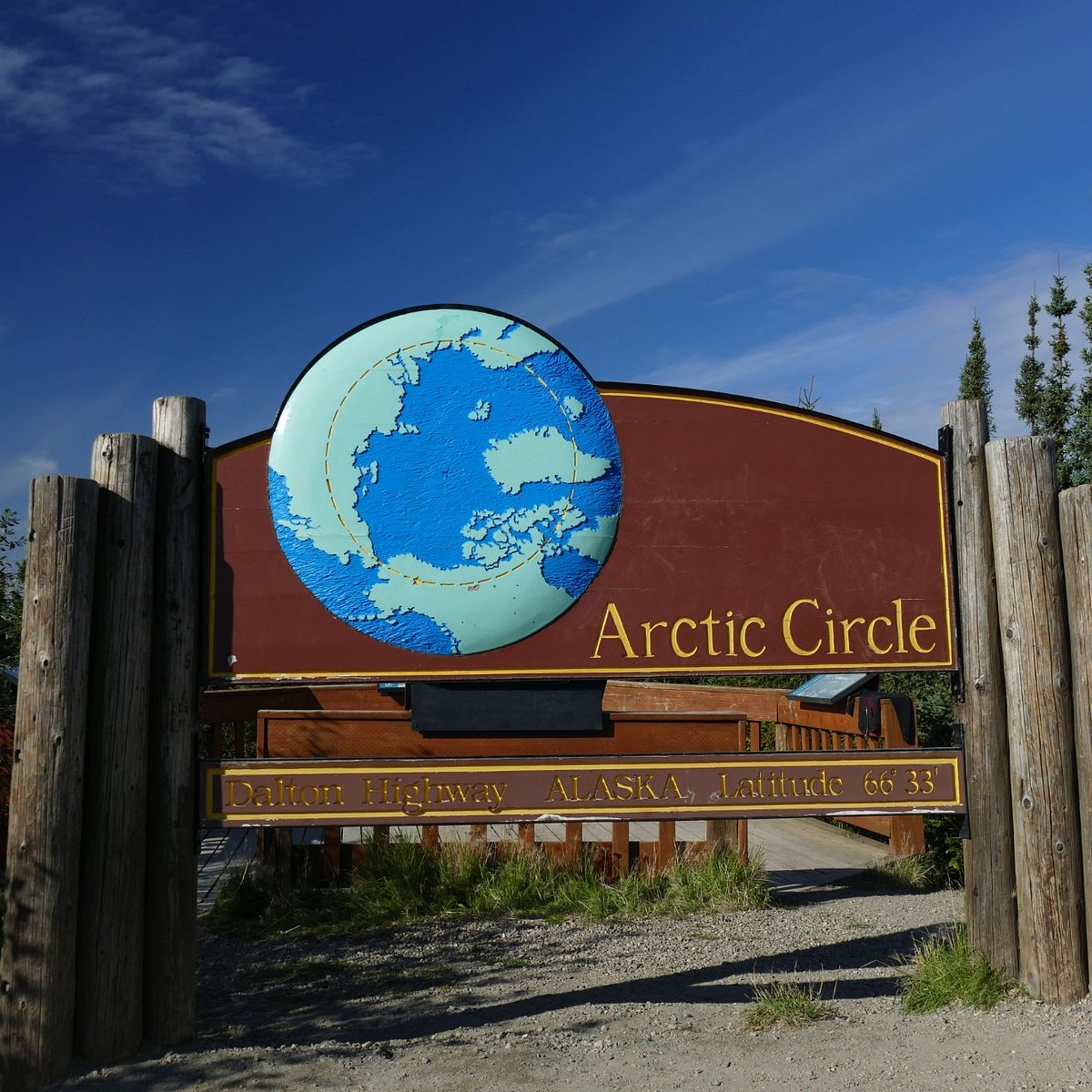
The Arctic Circle
Book a tour!Check off the Arctic Circle from your bucket list. Around three hours north of Fairbanks on the most dangerous road in America, the journey to the Arctic Circle is as impressive as crossing it!
-
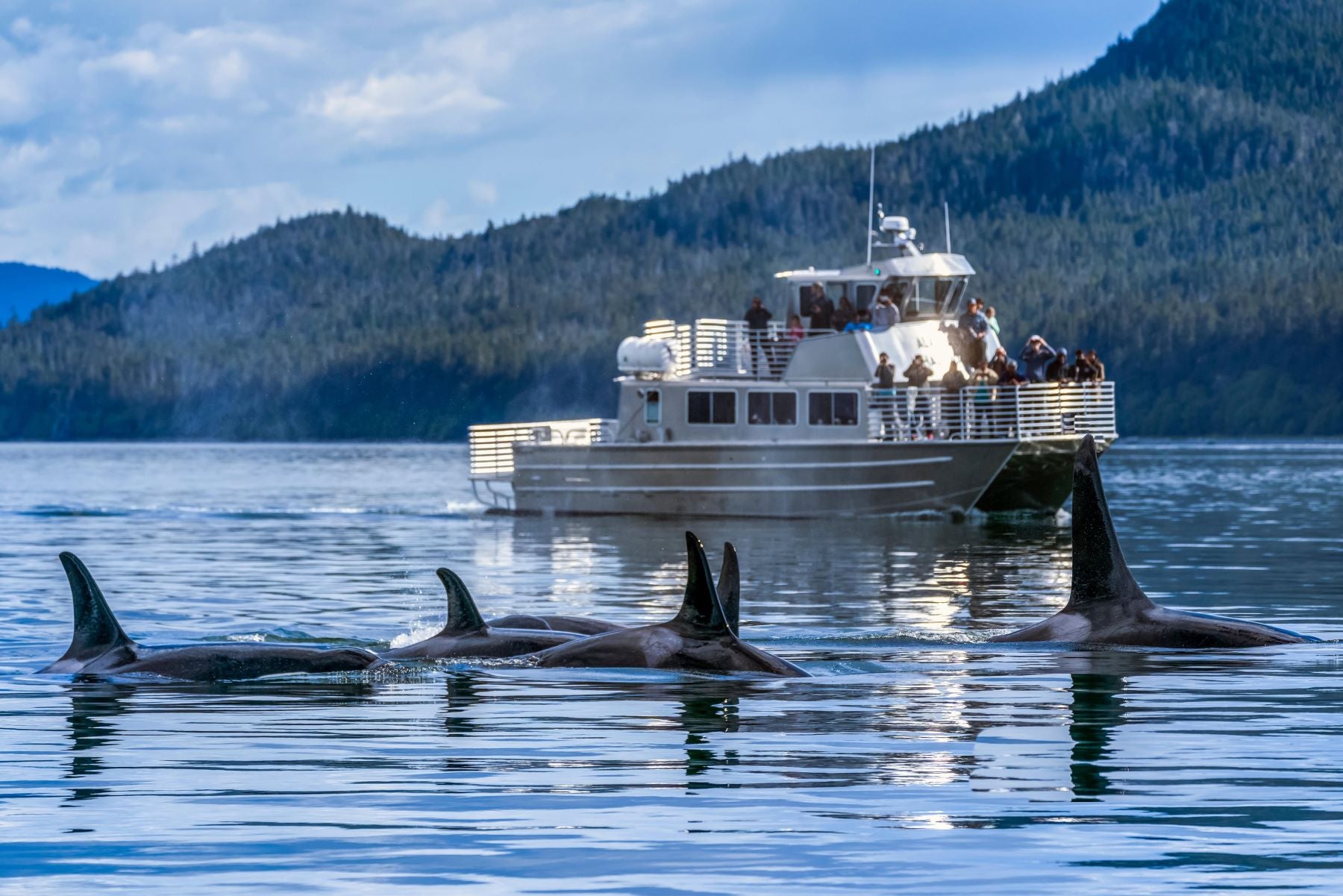
Glaciers and Whale Watching Boat Tours
Book a tour!Alaska is home to must-see wildlife, including whales, porpoises, seals, sea lions, and dolphins. The best way to get close to these animals is by boat on a guided tour.
-
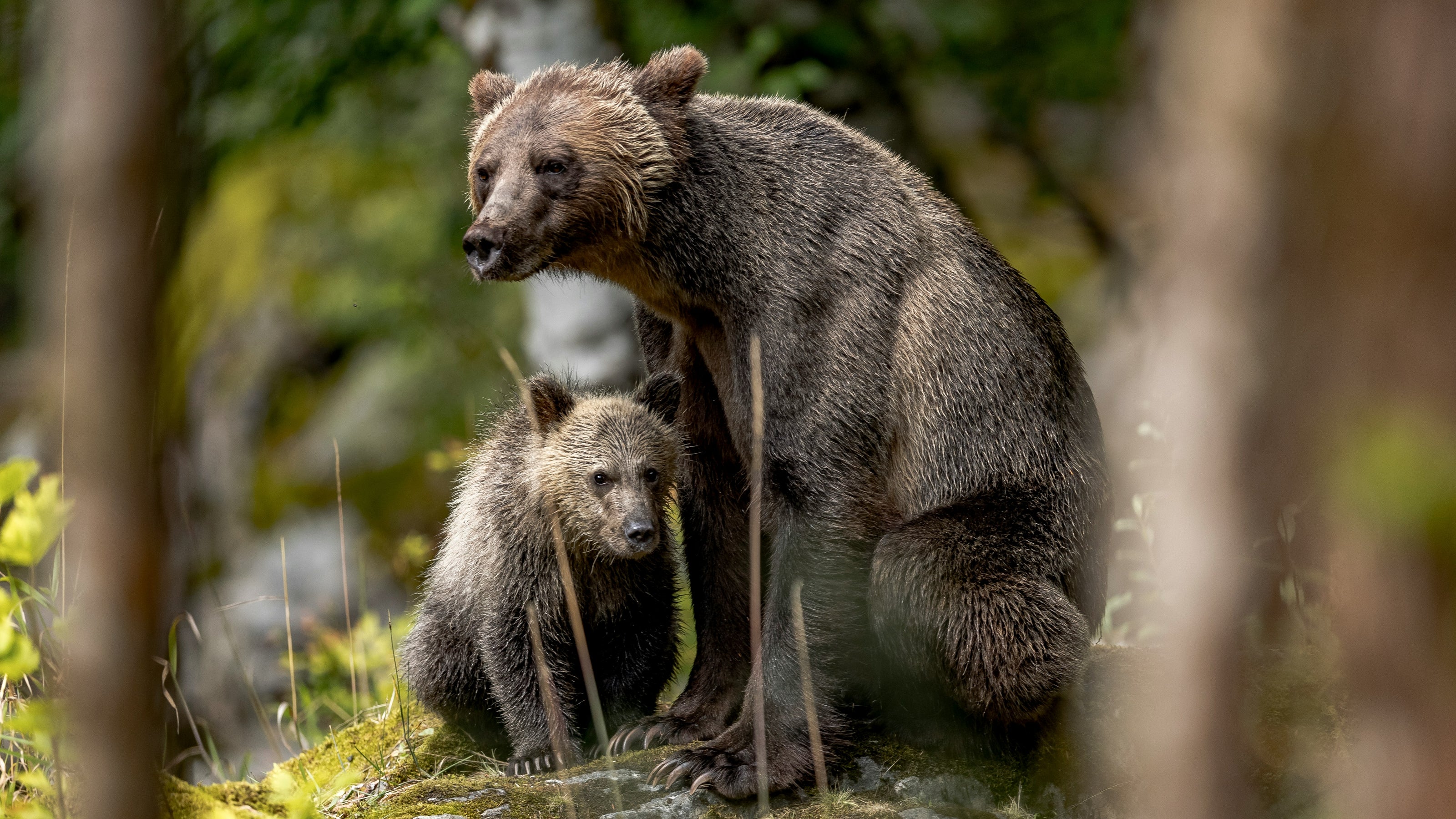
Wildlife Viewing
Book a tour!The backcountry of Alaska is home to mighty grizzly bears, moose, reindeer, and caribou. Book a tour to catch a glimpse of these beasts! The Large Animal Research Station (LARS) in Fairbanks is also a popular tourist attraction and place to view wildlife!
Frequently Asked Questions about traveling to Alaska
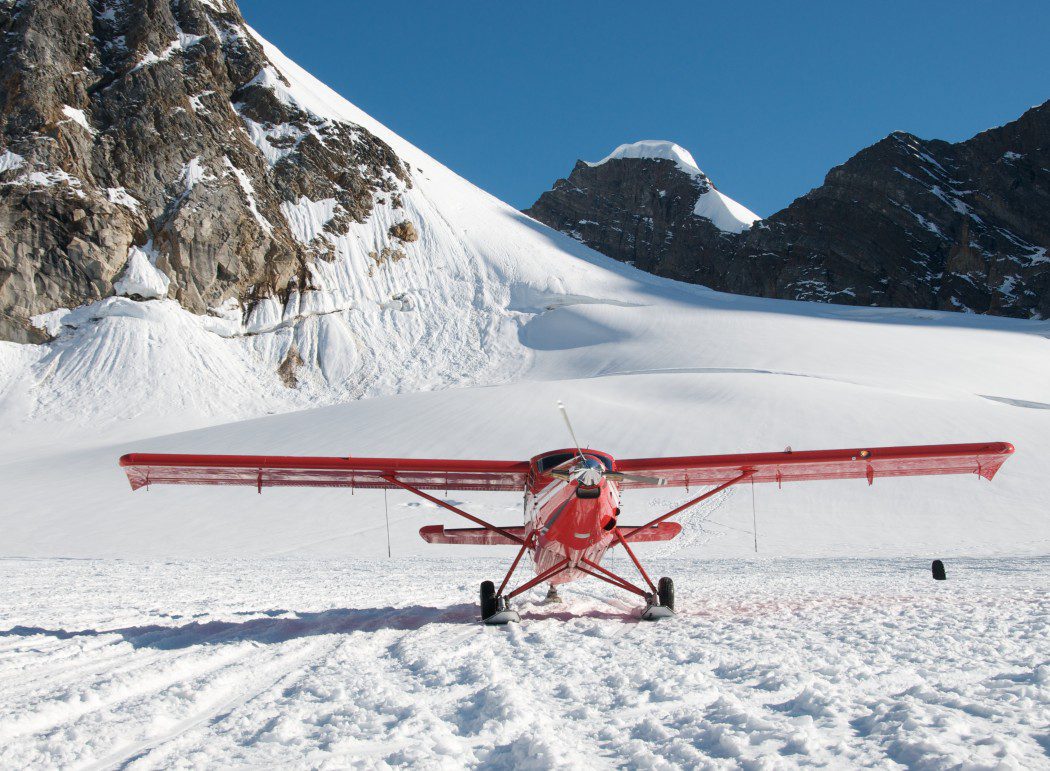
When should I go to see the aurora?
Aurora season in Alaska runs from late August to mid-April in Fairbanks and early August to mid-May in Anchorage. These months offer long, dark nights perfect for aurora viewing. The best time for clear skies and enhanced auroral activity is February to April, thanks to the equinox effect and drier weather.
There’s no need to check aurora activity or cloud cover forecasts too far in advance. Cloud cover predictions in Alaska are only reliable up to 24 hours at best, and aurora forecasts are most accurate just a few hours ahead. Occasionally, increased space weather activity may give 1-3 days’ notice of heightened aurora chances, but nothing is ever guaranteed.
To learn more about aurora forecasting, check out my blog article for detailed tips and tools. Remember, the aurora can appear on any clear night during aurora season, so plan to stay for several nights to maximize your chances of seeing this amazing phenomenon.
What should I pack?
Packing for an aurora tour in Alaska depends on the season, but staying warm is key, especially during winter. Here's a list of essentials:
Winter Gear (Late Fall to Early Spring):
- Layers for Warmth: Wool or synthetic base layers, a fleece or insulated mid-layer, and a heavy parka or down jacket.
- Bottom Layers: Wool long underwear, lined pants or fleece-lined leggings, and waterproof snow pants.
- Footwear: Insulated winter boots with thick wool socks.
- Accessories: Hat, gloves or mittens with liners, a balaclava or scarf to cover your face, and hand/toe warmers.
Year-Round Essentials:
- Camera Gear: DSLR or mirrorless camera, tripod, and extra batteries if you’re planning to photograph the aurora.
- Headlamp or Flashlight: Preferably with a red light setting to preserve night vision.
- Snacks and Water: To keep your energy up during late-night outings.
- Backpack: To carry extra layers, camera gear, and other essentials.
Summer/Fall Considerations (August to Early October):
- Waterproof Layers: A rain jacket and pants for unpredictable weather.
- Bug Spray: Mosquitoes can still be active in early fall.
Extra Tips:
- If you’re visiting in winter, ensure your rental car has winter tires and is properly winterized.
- Don’t skimp on cold-weather gear. Alaska winters can be extremely cold, and staying warm is crucial for enjoying the aurora.
- If you’re unsure about gear, many outfitters and rental shops in Alaska offer cold-weather clothing rentals.
How can I get to Alaska?
If you’re visiting Alaska to see the aurora, you’ll most likely fly into Fairbanks (FAI) or Anchorage (ANC). Fairbanks is closer to the auroral oval, making it one of the best places in the world for northern lights viewing. Anchorage offers more flight options and is a popular starting point for many travelers, especially those on cruises.
If you’re taking a cruise from Anchorage, you may have a few days in Fairbanks beforehand as part of a pre-cruise itinerary. Many cruise packages include shuttle services between Fairbanks and Anchorage, giving you a chance to explore both cities.
It’s also possible to drive to Alaska via the Alaska Highway, which connects to the lower 48 through Canada. However, this is a long journey, and it’s not recommended during the winter months due to unpredictable weather and road conditions.
Flying is the quickest and most convenient way to start your aurora adventure, with Anchorage and Fairbanks serving as the main gateways to Alaska’s northern lights!
What is there to do in Fairbanks?
Fairbanks has a lot to offer, with activities and attractions that show off the best of Alaska. Check out my visitor's guide to Fairbanks page for all the details. Here are some highlights:
- Watch the Aurora Borealis: Fairbanks is one of the top places in the world to see the northern lights, visible from late August to mid-April.
- Relax at Chena Hot Springs: Enjoy the warm hot springs and visit the Ice Museum, featuring ice sculptures and even an ice bar.
- Stop by the Morris Thompson Cultural and Visitors Center: Learn about Interior Alaska’s history, culture, and wildlife through free exhibits and films.
- Go Dog Sledding: Try mushing your own team of dogs or take a ride through the snowy landscapes.
- Check Out the World Ice Art Championships: This winter event showcases amazing ice sculptures and fun interactive displays.
- Visit the University of Alaska Museum of the North: Explore exhibits on Alaskan art, history, and wildlife, with great views of the area.
- Take a Trip to the North Pole: Just outside Fairbanks, this town has Santa’s House and fun holiday-themed attractions all year.
- Try Ice Fishing or Snowmobiling: Winter sports are a great way to enjoy frozen lakes and snowy trails.
- Ride a Riverboat: In summer, cruise along the Chena or Tanana Rivers and learn about local history and wildlife.
- Explore Pioneer Park: This free park has museums, historic buildings, and a glimpse into Fairbanks’ gold rush history.
Fairbanks offers a mix of outdoor fun, cultural activities, and beautiful sights to enjoy in any season!
What's the best rental car company?
Alaska 4x4 Rentals is the best choice for exploring Alaska. Their vehicles are fully winterized with engine block warmers, trickle chargers, and tires suited for the season, making them safe for icy roads and snowy conditions.
Other rental companies may provide cars that aren’t prepared for Alaska’s tough winters, which can be dangerous, especially in remote areas. Getting stranded in harsh weather can quickly become a serious situation. With Alaska 4x4 Rentals, you’ll have a reliable, safe car ready for Alaska’s roads, whether you’re chasing the aurora or heading into the wilderness.
How can I stay safe in the wild?
Staying safe in Alaska’s wilderness requires preparation and caution. Here are some tips:
- Carry Bear Spray: Always have bear spray with you, especially if you’ll be hiking or in remote areas.
- Bring a Satellite Phone: Cell service can be unreliable, so a satellite phone or emergency communication device is essential.
- Tell Someone Your Plans: Let friends or family know where you’re going and when you plan to return.
- Stick to Main Roads: Avoid remote, unmaintained roads, especially in winter.
- Pack Extra Water and Food: Be prepared in case of unexpected delays or emergencies.
- Download Offline Maps: Use your phone to download maps so you can navigate without cell service.
- Keep Your Gas Tank Full: Always fill up before heading out, as gas stations can be far apart.
- Watch for Moose: Stay alert while driving, especially at dawn, dusk, or in areas with moose crossing signs.
Planning ahead and staying aware can help ensure a safe and enjoyable trip into Alaska’s wilderness.
What wildlife will I see?
Fairbanks:
In Fairbanks, you might see moose along trails, near rivers, or even in town. Other common wildlife includes foxes, hares, and birds like ravens and chickadees. Beavers can often be spotted along the Chena River, and in more remote areas, you could encounter grizzly bears or wolves. During the summer, bald eagles are a common sight. For a closer look at Alaskan wildlife, you can book a tour at the Large Animal Research Station, where you can see muskoxen and learn about other native species.
Anchorage:
In Anchorage, moose are frequently seen in parks and on trails. You might also spot beluga whales in Cook Inlet or black and brown bears in the surrounding mountains. Dall sheep are often visible grazing on rocky hillsides. Bird enthusiasts can find bald eagles, ducks, and songbirds, while streams like Ship Creek attract salmon, drawing in other wildlife as well.
Both cities offer excellent opportunities to observe Alaska’s wildlife in their natural habitats or through guided tours and educational experiences.
What are my chances of seeing the aurora on my trip?
There’s no way to guarantee you’ll see the aurora, but the longer you stay, the better your chances. In Fairbanks, the aurora is out in some capacity every night because the city sits directly under the auroral oval. However, clear skies are key. Some people say staying three nights in Fairbanks gives you about a 90% chance of catching the lights.
In Anchorage, you’ll need a bit more auroral activity to see anything beyond a faint show on the northern horizon. While aurora tours and knowledge of space weather data can help maximize your chances, there’s always the possibility of not seeing the lights. That’s what makes aurora chasing so special—it’s a combination of luck and skill.
If the aurora were easy to see, everyone would have experienced it already! Embrace the unpredictability, and with patience and persistence, you might just catch one of the most incredible shows nature has to offer.
